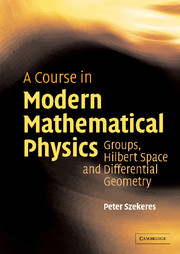Book contents
- Frontmatter
- Contents
- Preface
- Acknowledgements
- Dedication
- 1 Sets and structures
- 2 Groups
- 3 Vector spaces
- 4 Linear operators and matrices
- 5 Inner product spaces
- 6 Algebras
- 7 Tensors
- 8 Exterior algebra
- 9 Special relativity
- 10 Topology
- 11 Measure theory and integration
- 12 Distributions
- 13 Hilbert spaces
- 14 Quantum mechanics
- 15 Differential geometry
- 16 Differentiable forms
- 17 Integration on manifolds
- 18 Connections and curvature
- 19 Lie groups and Lie algebras
- Bibliography
- Index
1 - Sets and structures
Published online by Cambridge University Press: 05 September 2012
- Frontmatter
- Contents
- Preface
- Acknowledgements
- Dedication
- 1 Sets and structures
- 2 Groups
- 3 Vector spaces
- 4 Linear operators and matrices
- 5 Inner product spaces
- 6 Algebras
- 7 Tensors
- 8 Exterior algebra
- 9 Special relativity
- 10 Topology
- 11 Measure theory and integration
- 12 Distributions
- 13 Hilbert spaces
- 14 Quantum mechanics
- 15 Differential geometry
- 16 Differentiable forms
- 17 Integration on manifolds
- 18 Connections and curvature
- 19 Lie groups and Lie algebras
- Bibliography
- Index
Summary
The object of mathematical physics is to describe the physical world in purely mathematical terms. Although it had its origins in the science of ancient Greece, with the work of Archimedes, Euclid and Aristotle, it was not until the discoveries of Galileo and Newton that mathematical physics as we know it today had its true beginnings. Newton's discovery of the calculus and its application to physics was undoubtedly the defining moment. This was built upon by generations of brilliant mathematicians such as Euler, Lagrange, Hamilton and Gauss, who essentially formulated physical law in terms of differential equations. With the advent of new and unintuitive theories such as relativity and quantum mechanics in the twentieth century, the reliance on mathematics moved to increasingly recondite areas such as abstract algebra, topology, functional analysis and differential geometry. Even classical areas such as the mechanics of Lagrange and Hamilton, as well as classical thermodynamics, can be lifted almost directly into the language of modern differential geometry. Today, the emphasis is often more structural than analytical, and it is commonly believed that finding the right mathematical structure is the most important aspect of any physical theory. Analysis, or the consequences of theories, still has a part to play in mathematical physics – indeed, most research is of this nature – but it is possibly less fundamental in the total overview of the subject.
When we consider the significant achievements of mathematical physics, one cannot help but wonder why the workings of the universe are expressable at all by rigid mathematical ‘laws’.
- Type
- Chapter
- Information
- A Course in Modern Mathematical PhysicsGroups, Hilbert Space and Differential Geometry, pp. 1 - 26Publisher: Cambridge University PressPrint publication year: 2004



